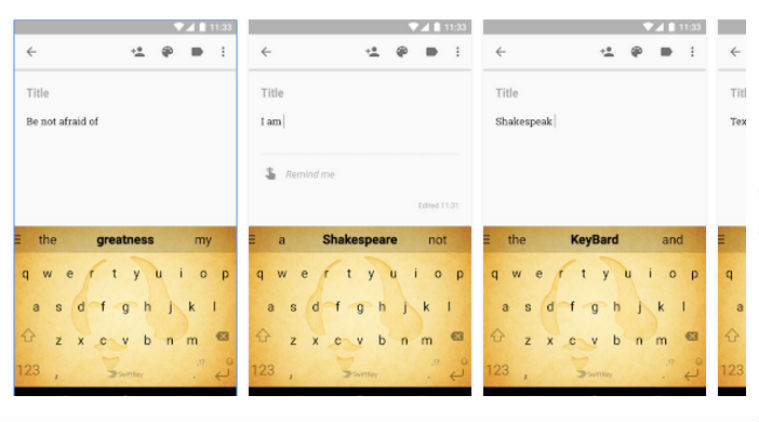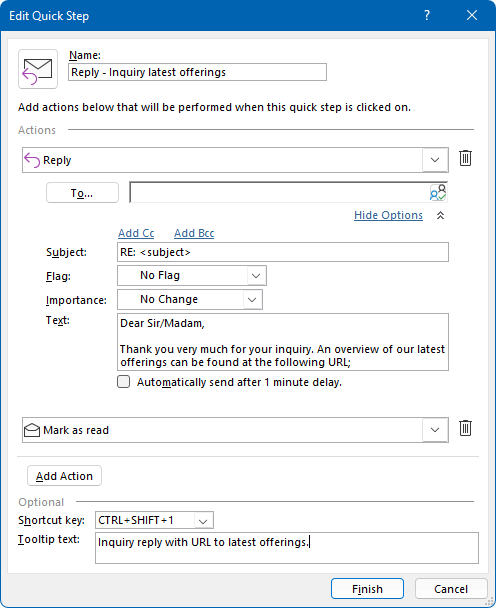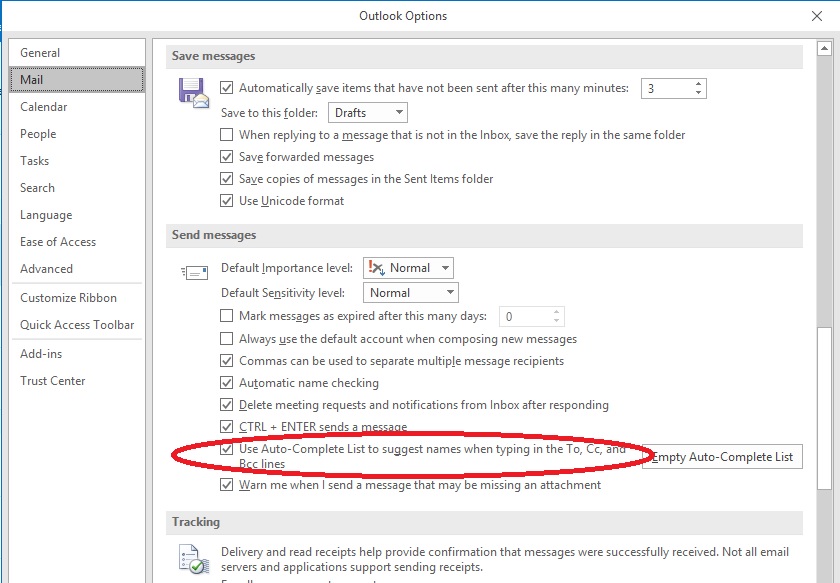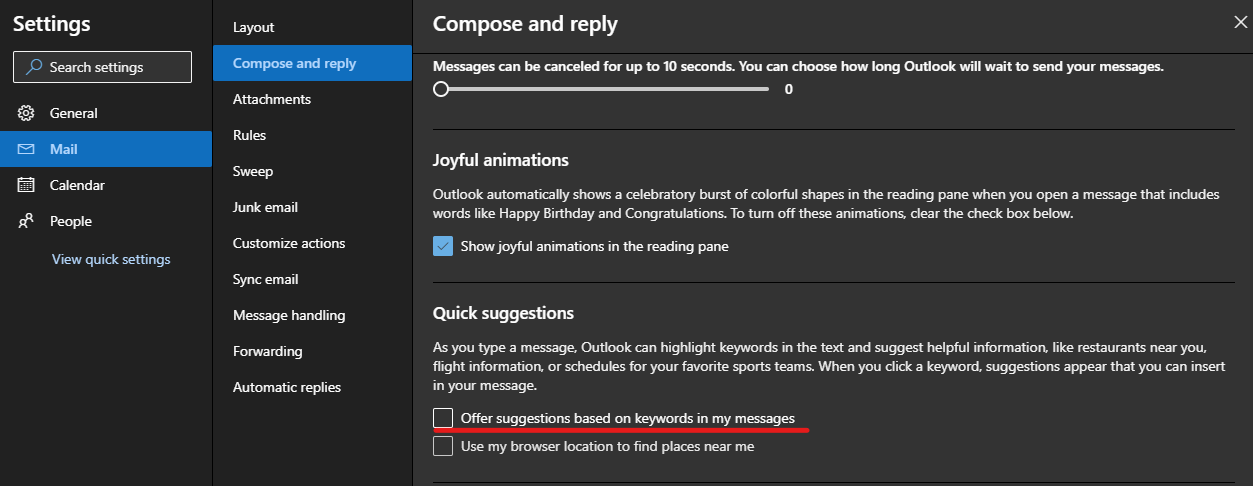Predictive Text Outlook 2016
How to edit quick parts (AutoText) in Outlook?
- Outlook Email
- Predictive Text Outlook 2016 Download
- Predictive Text Outlook 2016 Crack
- Predictive Text In Outlook 2016
May 12, 2020 The predictive text update is expected to be released this month. Writing and replying to emails in Outlook may soon be a little easier. Microsoft plans to add a predictive text feature, similar. Microsoft announced the upcoming release of a text prediction service in Word and Outlook last year. Text predictions, as the name suggests, predict words and phrases users are likely to type, and provide options to add these to texts with minimal effort. Sign in to vote. What editor are you using in Outlook these feature only works with Word as an Editor. Try open a new Mail and navigate to. On the Insert menu, point to AutoText, and then click AutoText. Select or clear the Show AutoComplete suggestions check box. May 19, 2020 Microsoft’s Outlook feature looks and acts very similar to Smart Compose. To use Outlook’s predictive text when composing emails, head into Outlook’s settings menu click ‘compose and reply’ ‘Text predictions’ check ‘suggest words or phrases as I type.’.
Quick parts and AutoText will save your time when you need to frequently enter same block entry in different email messages in Microsoft Outlook. Sometimes, you may need to edit the quick parts or AutoText, as results of spelling mistakes, updating information, formatting, and more. In this article, we will show you two methods about how to edit quick parts or AutoText in Microsoft Outlook easily.
Edit AutoText (quick parts) with AutoText feature in Outlook
Edit AutoText (quick parts) with Kutools for Outlook
- Auto CC/BCC by rules when sending email; Auto Forward Multiple Emails by rules; Auto Reply without exchange server, and more automatic features...
- BCC Warning - show message when you try to reply all if your mail address is in the BCC list; Remind When Missing Attachments, and more remind features...
- Reply (All) With All Attachments in the mail conversation; Reply Many Emails at once; Auto Add Greeting when reply; Auto Add Date&Time into subject...
- Attachment Tools: Auto Detach, Compress All, Rename All, Auto Save All... Quick Report, Count Selected Mails, Remove Duplicate Mails and Contacts...
- More than 100 advanced features will solve most of your problems in Outlook 2010-2019 and 365. Full features 60-day free trial.
Edit AutoText (quick parts) with AutoText feature in Outlook
This method will guide you to edit and redefine an existing AutoText in Microsoft Outlook with its AutoText feature. Please do as following:
Step 1: Create a new email message:
- In Outlook 2010 and 2013, please click the New Email button on the Home tab;
- In Outlook 2007, please click the File > New > Mail Message.
Step 2: In the Message window, click the Insert > Quick Parts > AutoText, and then click the AutoText name that you will edit later.
In our case, we select the AutoText of Kutools for Outlook. See screen shot above.

Notes:
(1) You need to put your cursor in the message body to activate the Quick Parts feature in the Ribbon.
(2) In Outlook 2007, please click the Insert > Quick Parts, and then click to the AutoText name.
Step 3: Then the AutoText is added into your message. Edit the block entry in your message based on your needs.
Step 4: Select the block entry, and then:
- In Outlook 2007, please click the Insert > Quick Parts > Save Selection to Quick Part Gallery.
- In Outlook 2010 and 2013, please click the Insert > Quick Parts > AutoText > Save Selection to AutoText Gallery. See screen shot:
Step 5: In the Create New Building Block dialog box, enter the original name of editing AutoText into the Name: Box, and then click the OK button.
In our case, we enter the original name of Kutools for Outlook in the Name: box. See screen shot:
Step 6: In the popping up warning dialog box, just click the Yes button.
Up to now, you have edited and redefined the existing AutoText in Microsoft Outlook, and you can view the edited AutoText with clicking the Insert > Quick Parts > AutoText (or Insert > Quick Parts in Outlook 2007) in Message window.
Edit AutoText (quick parts) with Kutools for Outlook
The second method is similar as the first one we introduced. However, Kutools for Outlook’s Auto Text utility can help you edit and redefine an existing AutoText much more visually and easier.
Kutools for Outlook is a useful add-in with dozens of handy tools, which makes you work much easier, faster, and efficiently in Microsoft Outlook.
Step 1: Create a new email message with clicking the New Email button on the Home tab in Outlook 2010 and 2013.
Step 2: In the Auto Text pane in the right, see screen shot:
- Firstly, click to select the category name that the AutoText you will edit belongs to;
- Then double click the AutoText name to insert it into your message. In our case, we double click the Kutools for Outlook.
Note: By default, the Auto Text pane shows in the far right of Message window. If the Auto Text pane disappears, please click the Kutools > Pane to activate it.

Step 3: In the message body, edit the block entry.
Step 4: Select the edited block entry, click the Add button at the top of Auto Text pane. See screen shot:
Step 5: In the popping up Auto Text dialog box, enter the original name of edited AutoText in the Name: box, and then click the OK button.
In our case, we enter the Kutools for Outlook in the Name: box. See screen shot:
Then the AutoText is edited and redefined in Outlook as soon as possible.
Note: The AutoText you add /edit/remove in the Auto Text Pane, will synchronously add /edit/remove into Microsoft Outlook’s AutoText gallery (Insert > Quick Parts > AutoText in Message window), and vice versa.
Kutools for Outlook - Brings 100 Advanced Features to Outlook, and Make Work Much Easier!
- Auto CC/BCC by rules when sending email; Auto Forward Multiple Emails by custom; Auto Reply without exchange server, and more automatic features...
- BCC Warning - show message when you try to reply all if your mail address is in the BCC list; Remind When Missing Attachments, and more remind features...
- Reply (All) With All Attachments in the mail conversation; Reply Many Emails in seconds; Auto Add Greeting when reply; Add Date into subject...
- Attachment Tools: Manage All Attachments in All Mails, Auto Detach, Compress All, Rename All, Save All... Quick Report, Count Selected Mails...
- Powerful Junk Emails by custom; Remove Duplicate Mails and Contacts... Enable you to do smarter, faster and better in Outlook.
or post as a guest, but your post won't be published automatically.
- To post as a guest, your comment is unpublished.Thank you for this explanation. It has helped me understand autotext and how to use it.
- To post as a guest, your comment is unpublished.THANK YOU SO MUCH! (what else do I need to stick here? I'm just trying to express my gratitude, I don't wanna type a longer message!)
Original KB number: 2199226
Summary
This article contains an overview of the Microsoft Outlook AutoComplete list (also known as the Outlook Auto-Complete list). In addition to describing the feature, this article contains more information and step-by-step instructions for advanced users to manage the list.
More information
Outlook maintains the AutoComplete list. The list is used by both the automatic name-checking feature and the automatic completion feature. The AutoComplete list, also known as the nickname cache, is generated automatically when you send email messages from Outlook. The list contains SMTP addresses, LegacyExchangeDN entries, and display names for people to whom you have sent mail previously.
Note
The AutoComplete list for Outlook is specific to Outlook and is not shared by Outlook Web App (OWA). OWA maintains its own AutoComplete list.
The following sections provide information about the AutoComplete feature.
Limit to the number of entries
Outlook limits the number of entries that you can save in the AutoComplete list. After you reach this limit, Outlook uses an internal algorithm to determine the best names to remove from the list. It does this based on a usage weighting. So, you may find some names unexpectedly removed from your nickname cache. There are two general approaches that you can use to avoid this situation:
- You can proactively remove AutoComplete list entries that you no longer need. This is the preferred approach. For more information about how to do this, see the How to remove AutoComplete list entries one at a time section.
- You can increase the limit for the nickname cache. Because this configuration is untested, we don't recommend it. If you have a larger nickname cache, you could also lose a larger number of cached entries if your nickname cache becomes unusable because of corruption. For more information about how to increase the limit, see the How to change the limit for the AutoComplete list section.
The limits are as follows:
- Outlook 2019: 1,000 entries
- Outlook 2016: 1,000 entries
- Outlook 2013: 1,000 entries
- Outlook 2010: 1,000 entries
- Outlook 2007: 2,000 entries
- Outlook 2003: 1,000 entries
How to enable the AutoComplete feature
Outlook Email

This section details how to enable or disable the AutoComplete feature.
Outlook 2010, Outlook 2013, Outlook 2016, and Outlook 2019
To access the AutoComplete setting, follow these steps:
On the File menu, select Options.
Select the Mail tab.
Scroll approximately halfway down until you see Send messages. Make sure that the Use Auto-Complete List to suggest names when typing in the To, Cc, and Bcc lines box is checked.
Outlook 2003 and Outlook 2007
To access the AutoComplete settings, follow the steps:
Select Tools, and then select Options.
Select the E-mail options button.
Select the Advanced E-mail Options button.
Make sure that the Suggest names while completing To, Cc, and Bcc fields box is checked. (The screenshot for this step follows.)
How to import .nk2 files into Outlook 2010, Outlook 2013, Outlook 2016, and Outlook 2019
Microsoft Office Outlook 2007 and earlier versions store the AutoComplete list in a nickname (.nk2) file on the disk. Outlook 2010, Outlook 2013, Outlook 2016, and Outlook 2019 store the AutoComplete list as a hidden message in your primary message store. Outlook 2010, Outlook 2013, Outlook 2016, and outlook 2019 let you import the older .nk2 files.
Predictive Text Outlook 2016 Download
For more information about how to import .nk2 files in Outlook 2010, see Import Auto-Complete List from another computer.
How to copy the AutoComplete list
The steps to export and import the AutoComplete list are different, depending on the version of Outlook that you're using.
Outlook 2010, Outlook 2013, Outlook 2016, and Outlook 2019
To copy the AutoComplete list, follow these steps:
Step 1
To export the AutoComplete mailbox message, follow these steps:
- Exit Outlook, and then close Outlook Web Access or Outlook Web App (OWA) on all workstations that are connected to your mailbox.
- Download and install MFCMAPI.
- Run mfcmapi.exe.
- On the Session menu, select Logon.
- If you're prompted for a profile, select the desired profile name, and then select OK.
- In the top pane, locate the line that corresponds to your mailbox, and then double-click it.
- In the left-side navigation pane, expand Root Container, and then expand Top of Information Store or IPM_SUBTREE.
- Right-click the Inbox folder, and then select Open Associated Content Table. This action opens a new MFCMAPI window that contains various properties.
- Under the Subject column, right-click the item that has the subject IPM.Configuration.Autocomplete, and then select Export Message. This action opens the Save Message To File window.
- In the drop-down list, select MSG file (UNICODE), and then select OK.
- Select a folder location to which you want to save the message, and then select Save. Note this location.
Step 2
To import the AutoComplete mailbox message, follow these steps.
Exit Outlook, and then close Outlook Web Access or Outlook Web App (OWA) on all workstations that are connected to your mailbox.
Download and install MFCMAPI.
Run mfcmapi.exe.
On the Session menu, select Logon.
If you're prompted for a profile, select the desired profile name, and then select OK.
In the top pane, locate the line that corresponds to your mailbox, and then double-click it.
In the left-side navigation pane, expand Root - Mailbox, and then expand Top of Information Store or IPM_SUBTREE.
Right-click the Inbox folder, and then select Open Associated Content Table. This action opens a new MFCMAPI window that contains various properties.
To avoid duplicate entries, you must delete the existing AutoComplete message.
Note
Before you delete the IPM.Configuration.Autocomplete message, you must export the message by using the steps in the How to copy the AutoComplete list section.
To delete the existing AutoComplete message, follow these steps:
- In the Subject column, locate the item that has the subject IPM.Configuration.Autocomplete.
- Right-click the item, and then select Delete message. This opens the Delete Item window.
- In the drop-down list, select Permanent deletion (deletes to deleted item retention if supported), and then select OK.
On the Folder menu, select Import, and then select From MSG.
Locate the .msg file that you created in step 11 of the How to copy the AutoComplete list section, and then select OK.
In the Load MSG window that appears, select Load message into current folder in the Load style list, and then select OK.
The AutoComplete information is imported from the IPM.Configuration.Autocomplete_<hexadecimal code>.msg, where the placeholder <hexadecimal code> represents a long string of numbers and letters.
Outlook 2007 and Outlook 2003
The steps to copy the AutoComplete list in Outlook 2003 and Outlook 2007 are different. This is because Outlook 2003 and Outlook 2007 store the AutoComplete list in the .nk2 file.
To copy the AutoComplete list in Outlook 2007, see Import or copy the Auto-Complete List to another computer.
How to remove AutoComplete list entries one at a time
To remove entries from the AutoComplete cache one entry at a time, follow these steps:
- Open a new email message.
- Type the first few characters of the AutoComplete entry that you want to remove.
- When the entry appears in the list of suggestions, move your mouse pointer over the suggestion until it becomes highlighted, but don't select it.
- When the X icon appears next to the highlighted suggestion, select X to remove the entry from the list, or press the Delete key on the keyboard.
Selecting X will prevent that entry (name) from appearing in the AutoComplete list again but won't remove it from your account. This entry may still appear in other areas in Outlook (such as search boxes).
Note
If you send a person a new email after you've removed their name from the AutoComplete list, their information will be added back to the list.
How to clear the whole AutoComplete list
This section explains how to delete the AutoComplete list.
Outlook 2010, Outlook 2013, Outlook 2016, and Outlook 2019
Use one of the following two methods to delete the AutoComplete list.
Method 1
Open Outlook.
On the File tab, select Options.
Select the Mail tab.
Under Send Messages, select Empty Auto-Complete List.
Select Yes.
Method 2
Start Outlook by using the /CleanAutoCompleteCache switch. To do this, follow these steps:
- Select Start, and then select Run.
- Type Outlook.exe /CleanAutoCompleteCache.
Note
If Outlook is not installed in the default location, you must point to the path of Outlook.exe.
Outlook 2007 and Outlook 2003
To delete the AutoComplete list in Outlook 2003 and Outlook 2007, you must manually delete the .nk2 file. To delete the .nk2 file, follow these steps:
Exit Outlook.
Select Start, and then select Computer.
Select Organize, and then select Folder and search options.
On the View tab, select Show hidden files, folders, and drives.
Select OK.
Select Start, select All Programs, select Accessories, and then select Run.
In the Run dialog box, type the following command (including the quotation marks), and then select OK:
C: UsersUserNameAppDataRoamingMicrosoftOutlook
Note
Username in this path is the name of the currently logged on Windows user.
Right-click the .NK2 file that has name of the profile that you want to reset, and then select Rename.
Rename the file as profilename.bak, and then press Enter.
Start Outlook.
Issues with the AutoComplete cache
This section describes known issues that can occur with the AutoComplete cache. The AutoComplete cache can become corrupted over time and may not save new entries. If this happens, you can try to remove individual entries from the list. To do this, see the How to remove AutoComplete list entries one at a time section. If that doesn't resolve the issue, the whole AutoComplete list can be reset. To do this, see the section titled 'How to clear the whole AutoComplete list.'
How to change the limit for the AutoComplete list
Because this configuration is untested, we don't recommend it. If you have a larger AutoComplete list, you could also lose a larger number of cached entries if your AutoComplete cache becomes unusable because of corruption. Given this disclaimer, you can use the following registry data to increase the AutoComplete list limit in Outlook.

Important
This section, method, or task contains steps that tell you how to modify the registry. However, serious problems might occur if you modify the registry incorrectly. Therefore, make sure that you follow these steps carefully. For added protection, back up the registry before you modify it. Then, you can restore the registry if a problem occurs. For more information about how to back up and restore the registry,see How to back up and restore the registry in Windows.
Exit Outlook.
Start Registry Editor.
- In Windows 8.x, press the Windows key, type regedit and then press Enter.
- In Windows 7 and Windows Vista, select Start, type regedit in the Start Search box, and then press Enter.
Locate and then select the following registry subkey:
HKEY_CURRENT_USERSoftwareMicrosoftOffice<x.0>OutlookAutoNameCheckNote
The placeholder <x.0> in this registry subkey represents your version of Microsoft Office. Use the appropriate value from the following list.
- Outlook 2019 = 16.0
- Outlook 2016 = 16.0
- Outlook 2013 = 15.0
- Outlook 2010 = 14.0
- Outlook 2007 = 12.0
- Outlook 2003 = 11.0
On the Edit menu, point to New, and then select DWORD value.
Type MaxNickNames, and then press Enter.
On the Edit menu, select Modify.
Type the new value for the limit, and then select OK.
Note
- Make sure that you type the number in decimal form. That is the correct form in which to type the number.
- Try increasing the limit by only a marginal amount to test the new limit. For example, to create a 20 percent increase in the limit in Outlook 2013, you would specify 1200 for the
MaxNickNamesvalue.
Exit Registry Editor.
Start Outlook.
Predictive Text Outlook 2016 Crack
Note
Predictive Text In Outlook 2016
The MaxNickNames registry value merely specifies the nondefault limit. Therefore, you can also use this value to lower the limit of the nickname cache.